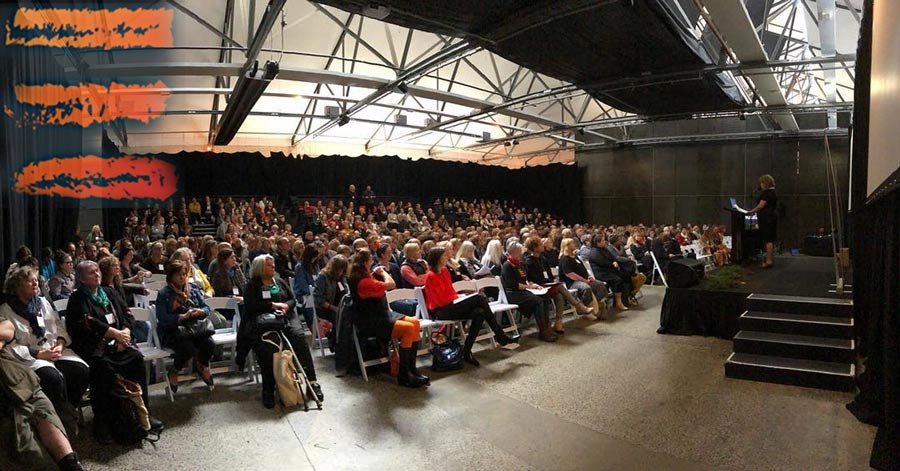How did the people of Hobart respond to the event?
The Triennale was well-supported by local galleries, TMAG, UTAS and those further afield around Tasmania who planned exhibitions for the Triennale period.
A few local artists worked with Nanna Bayer and Selena de Carvalho on the fire sculpture and preparing plinths for the exhibition display. Waldies School, in Lower Snug, was also a busy hub in the 2 years-long lead-up – meetings, workshops and storage of Triennale paraphernalia.
Was there a national and international buzz about the event?
Excitement built gradually over the preceding year with many people supporting us with early-bird registrations. Social media helped to spread the word and, with a 4-year gap since the last event, people were very keen to come along. Hobart also held a wonderful appeal, especially for those who had not previously visited the state.
I know it was a sell-out, but how many people attended and where were they from?
The event attendance was close to 700 – around 100 presenters and demonstrators, 60 volunteers and over 540 delegates (mostly full, 4-day attendance, but also including 1, 2 and 3-day attendance).
Attendance numbers:
International: 6% (45 people) from 14 different countries: 19 from New Zealand; 26 from Argentina, Canada, China, Denmark, Estonia, Finland, Great Britain, Netherlands, Norway, Philippines, Poland, United Arab Emirates and the USA.
Australia:
ACT 3% (24), NSW 20% (204), NT 2% (12), QLD 12% (81), SA 4% (30), TAS 18% (125), VIC 20% (141), WA 5% (32)
What do you think the average working potter got from attending the Triennale?
Connection with the broad ceramics community, stimulating exhibitions, rich and engaging discourse, a broad range of demonstrations from amazing international, national and local makers. We also ensured delegates had opportunities to sell their work through The Pot Shop and the Makers Fair.
We provided spaces for people to relax and gather in the lounge areas (complete with a local barista), the bar and around the forecourt food trucks. There was something for everyone!
What were the standouts for you?
I loved the location – Princes Wharf 1. To be on the harbour with the huge Aurora Australis sitting at the wharf, casting its bright orange reflection into the space and the shimmering water constantly changing, I found that a special treat.
We set-out to welcome all, to be as inclusive as possible, to bring together the newbies with the experienced. Within our means, I think we did well.
Potters love to get together. They love to see what’s happening in our world, to catch up with friends and those they know through social media, to meet those they admire. They love to talk, watch others making, be challenged with new ideas, and generally be part of the tribe.
Our pop-up igloo, ‘Ask the Doctor’, where you could consult an expert with a ceramic dilemma, was really cute too.
Pot Luck dinner was a huge success, with the local migrant Resource Centre cooking delicious soup for 600 people. Bowls were swapped (behind the scenes) from one potter to another, and people gathered around the forecourt fires enjoying their steaming hot soup, listening to great local music and enjoying the Hobart welcome. The fire sculpture brought to 1300ºC in the petal kiln over 50 hours was a fantastic spectacle, drawing in the local Hobart community as well as delegates.
The opening of the kiln to reveal the red-hot sculpture was just incredible – a challenging, inspiring and magical project!
You had an impressive team of people helping – how did the back-office manage to achieve so much?
Despite starting with a substantial group of interested Tasmanians in the initial planning stages (2 years out), the Tasmanian committee slowly reduced to a core group of 3 amazing people with me joining as Chair in October 2018.
We enjoyed the support of approximately. 60 volunteers in the month leading up to the event, bump-in day, the 4 event days and the bump-out day. Such events would not be possible without this volunteer effort. TACTT was well-funded by national, state and local government which gave a significant boost to the creative program, allowing artists, authors, arts administrators and curators to be paid for their skills and expertise.
The Triennale is a major undertaking – would you consider making it a more frequent gathering?
Personally no, but it’s not up to me.
Any final thoughts you’d like to share?
Every one of these 15 events has been unique, tapping into the local environment and community. In 2022, it’s Alice Springs’ turn … can’t wait to see those big starry skies and getting to meet the local indigenous communities. I hear they’re excited!

